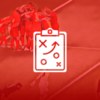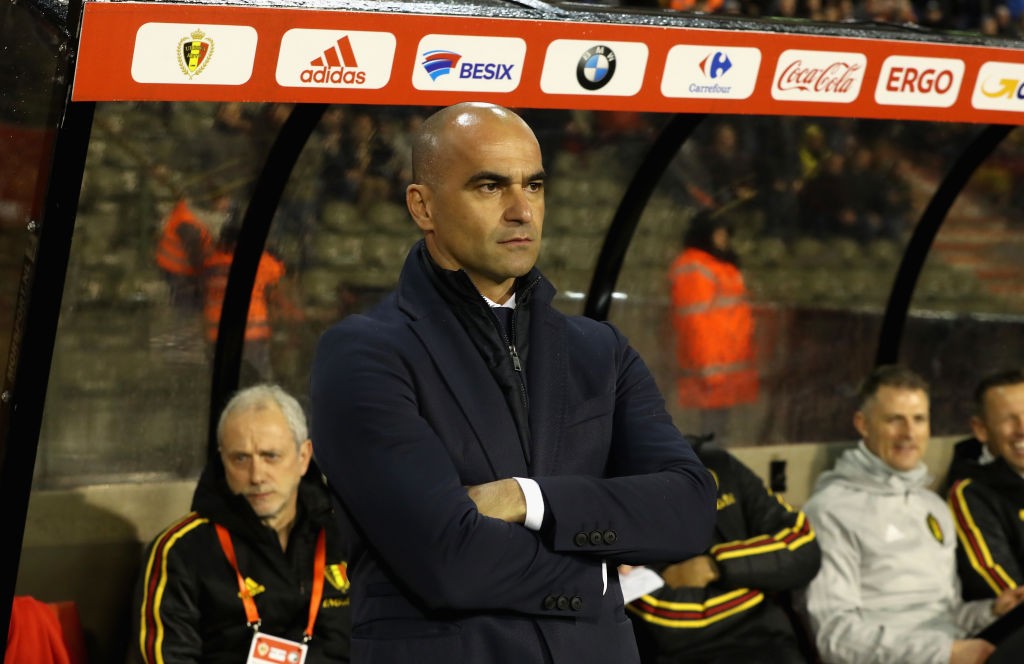Hamoudi Fayad provides a detailed tactical analysis of the Euro 2016 game which finished Belgium 0-2 Italy.
Belgium and Italy played against each other in what was the best match of the round on paper. Despite the lack of star names in the squad, Italy are very much a big name and on the night faced one of the best international teams in the world who initially failed to impress. Even though the second half saw an awakening from the Red Devils, their performance wasn’t suited to the caliber and style of play of the players at hand.
Belgium 0-2 Italy
Line-Ups

Made using Tactical Pad
A 5-3-2 from Italy, which relied on the wing backs stationing themselves high up the pitch and sitting back in their shape in the defensive phase, and the movement of both outer central midfielders into the half spaces and wings to exploit the space in the channels.
For Belgium, a classic 4-2-3-1 with an unconventional attacking midfielder in Fellaini who focused on winning headers and marking Daniele de Rossi. Hazard and De Bruyne both failed to exploit the space in between the lines to a great extent and Lukaku’s lateral movement was decent at best.
Fellaini marks De Rossi with no support
From the outset of the match the main feature was Fellaini’s distance away from Italy’s best midfielder Daniele De Rossi. The bulky Belgian was touching distance away from the Italian who was, at the age of 32, not able to put in a shift for the team while being marked the whole time. Fellaini rarely left de Rossi alone, making sure that every time Italy attempted to build out of the back they would have to progress via their centre backs and not the Roma man himself.
Belgium’s 4-2-3-1 formation had Fellaini at the tip of attacking midfield who offered next to nothing in attack with his headers failing to have their expected effect. Belgium completed only 30% of their 10 crosses in the first half, with Vertonghen and Ciman taking half of them. Their roles, in the absence of a creative attacking midfielder thanks to the partial isolation of Hazard and De Bruyne, were limited to diagonal balls and attempted switches of play. Unfortunately for Belgium, it was laborious and lackluster.
Fellaini’s marking of De Rossi wasn’t supported by Hazard, Lukaku and De Bruyne and this led to a large extent of comfort from the Italian central defensive trio. This improved from Belgium in the second half when Lukaku and De Bruyne started to use their bodies to force the Italian defenders to camp in their box while building play. However, in the first half it was the reason for the happening of the Italians’ opening goal.
Bonucci is in the mould of Mats Hummels and Jerome Boateng, in the sense that they can use their feet not just to tackle and intercept but also to create. Without Pirlo and now De Rossi, Conte had little to worry about with the Juventini trio at the back. Bonucci, the best out of the 3 technically, played a wonderfully hit pass to Giaccherini who slotted it past Courtois to put Italy in the lead. This was an odd move from Belgium, who were prone to more than one Bonucci pass on the night. Fortunately for the Red Devils, Pelle wasn’t as nimble as Giaccherini and failed to capitalize on the chances.
Italy offensive combinations spearhead attack
Italy’s central defenders’ task, now that they were free from any pressure from the forwards, was to catalyse play into attack. Italy’s defenders were easily bypassing the midfield via laser (grounded line-breaking passes) passes to the strikers to lay it off to the onrushing central midfielders, or through long balls from Bonucci. This was successful and create a variety of problems around Belgium’s midfield shape. With the front 4 relatively passive, Nainggolan and Witsel had the task of anticipating all of the opposition midfielders’ runs and movement.
Italy’s attacking threat was only minimised by Eder and Pelle who weren’t sharp in the first half, only helping with holding up play and not making runs into the channels. It seemed they lacked understanding and mobility up front to support their onrushing teammates.
In the play unfolding above, we can see the following:
- A lack of support for Belgium’s players in the build-up play
- Italy’s ability to play grounded combinations between Belgium’s lines
- Italy’s ability to shift play towards the half spaces / wings via central midfielders
- Italy’s defensive block which is 7v2 with Belgium’s players at the end, thanks to coordination
Belgium with no answers to Italy position-oriented marking
Italy’s position-oriented zonal marking saw them shift from their 5-3-2 defensive shape into a situational 4-4-2 to battle Belgium’s build-up play through the flanks. The 3 narrow central midfielders plus the onrushing wing back allowed Italy to cover the central zones more than adequately while also halting Wilmots’ men’s inefficient progression up the pitch.
The Azzurri often left space between the central defenders and central midfielders, but this was helped by the fact that a defender from the back 5 could step up into midfield and block any passes into the space behind them. Italy had the benefit of 3 defenders who do not just play but excel together at club level and the understanding between them was a big factor in their tactical victory over Belgium’s talented attacking line-up.
De Bruyne and Hazard struggled with this shape and more so Lukaku, who failed to provide anything to remember against 3 defenders. Left alone without a dynamic midfielder behind him in the form of De Bruyne for example, Lukaku was isolated and very rarely supported by Fellaini’s late movement into the box. Likewise, Nainggolan and Witsel were far from exceptional in this match. Belgium lacked a tempo-setter, something that most of the big teams (Italy, Germany, Spain) at the tournament have. For France, they have dynamic central midfielders who can support the immobile striker (Giroud). A mixture of Fellaini and Lukaku was unsuccessful in this sense, especially against a team very well-coordinated in pressing and moving as one shape.
This is why Belgium’s build-up play failed. No matter how good the defenders are at building up play, support from the midfielders is needed. Even with Italy, who have 3 technically brilliant defenders, they needed De Rossi who, despite being occupied by Fellaini, to be aware of when and where they needed him to be to allow the progression of play up the pitch. Belgium’s defenders, as good as Toby Alderweireld, Thomas Vermaelen and Jan Vertonghen are in helping the build-up play, lacked any supporting figures in their bid to progress up the pitch.
Coordinated pressing leads failed Belgium awakening
At the start of the second half, Belgium began to play proactively by having Lukaku, Hazard and De Bruyne press all of the 3 Italian defenders and force them to camp in their own box. Italy initially struggled to play against Belgium’s press, especially with the sudden change in the situation of the match. As previously mentioned, Italy’s defenders were easily bypassing the midfield via laser (grounded line-breaking passes) passes to the strikers to lay it off to the onrushing central midfielders, or through long balls from Bonucci but this time needed to re-adapt to the situation at hand.
The problem with Belgium in this case was the clash of styles. On one hand, you have the dynamism of Hazard and top notch awareness of De Bruyne and on the other hand the immobile Fellaini and the bulldozer Lukaku. Couple that up with a lack of structure from the front line all the way until the back line, Wilmots and his men would struggle against the near-perfect Italians.
It was an odd decision not to play Mertens and Origi, both of whom would have complemented Belgium’s attacking structure and their pressing capabilities from the start of the match. As we saw earlier, Fellaini’s lone marking allowed Bonucci to play the pass into Giaccherini for the winner. Belgium looked different after 60 minutes, with Mertens coming in on the left hand side and Fellaini moving back alongside Witsel, although at that point the Italians had begun to nullify the threat much more easily.
What next?
Prematurely, the Azzurri are being called favourites for the tournament while there are already calls for Wilmots to leave Belgium after the tournament. If Belgium lack a coordinated structure in the coming matches they are bound to struggle, meanwhile Italy need understanding up top to complete the fantastic organisation they have across the whole pitch.
Written by Hamoudi Fayad
- Hipster Guide 2016-17: Bayer Leverkusen’s tactics, key players and emerging talents - August 25, 2016
- Talent Radar: Saudi Pro League 10 Young Players (U-23) to Watch in 2016-17 - August 23, 2016
- Dry Grassroots: Youth Football Deficiencies in Western Asia - July 19, 2016
























































